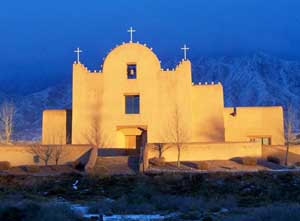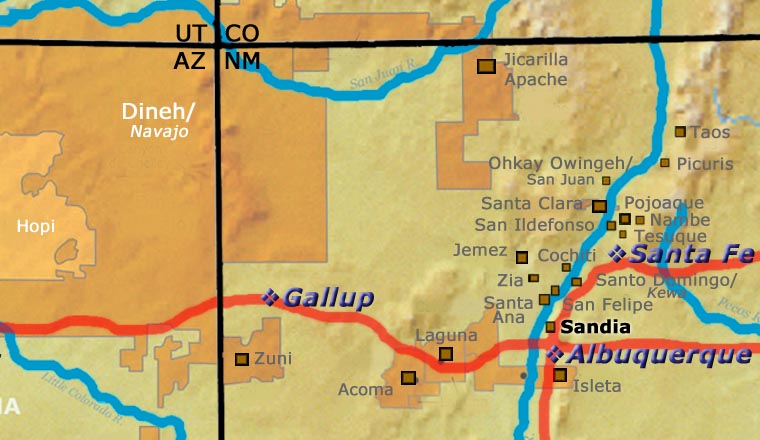
Sandia Pueblo

St. Anthony Catholic Church
The ancestors of today's Sandia Pueblo founded a pueblo in the area of what is now Alameda around 1300 CE, in the bosque along the Middle Rio Grande. When Francisco Vasquez de Coronado arrived in 1539, that pueblo consisted of more than 3,000 members. Today that population is down to about 500. The people speak Tiwa and say their lineage goes back to immigrants coming north from the Aztec areas in central Mexico.
Today's Sandia Pueblo occupies about 22,877 acres of land on the north side of Albuquerque, bounded on the east by the Sandia foothills and on the north and west by the Rio Grande bosque (a forested area where the tribe gets their firewood and wild game).
Like the other New Mexico pueblos, the Sandias participated in the Pueblo Revolt of 1680. The Spanish were evicted from the area but returned in 1681. The Sandias fled to the Hopi mesas and Governor Otermin ordered his troops to burn the abandoned pueblo. The Sandias returned shortly after and began to rebuild. The Spanish returned again in 1692 under Don Diego de Vargas and retook Nuevo Mexico. The Sandias ran from de Vargas and took refuge among the Hopi again. While they were gone, de Vargas had their main village burned again. Within a couple years, the Sandias had begun to trickle back again.
In the land of the Hopi, the Tiwas were encouraged to gather together with other refugees from the Rio Grande area and build a new pueblo for themselves on a northern finger of Second Mesa. That village was named "Payupki" and potsherds found there have been used to define the Payupki Phase of historic Hopi pottery shapes and designs (Sikyatki-Awatovi/San Bernardino/Payupki/Polacca A-D/Hano Polychrome). However, by the early 1740s, there was antagonism developing between the settlers at Payupki and the Hopis of Second Mesa. Then came a group of Franciscan monks intent on getting the runaway Tiwas to return to the Rio Grande valley. Those monks made lots of promises to the Tiwas, trying to get them to move back, and they eventually succeeded. However, none of those promises were ever honored by the Spanish authorities or by the church.
By 1742, 441 Sandias (and several Hopis) had resettled in the area of the former Alameda pueblo. They were raided almost continually until 1762, when Governor Tomas Capuchin ordered the pueblo be rebuilt properly, as a buffer between the Spanish settlement at Albuquerque and raiders coming from the north. The Governor also thought offering housing to the Hopis who accompanied the Sandias might be helpful in furthering the cause of the Spanish among the Hopis in Arizona but it didn't work out that way. Instead, the Hopis were segregated by the Spanish troops and housed where they would bear the brunt of the worst raids, until Governor Juan Bautista de Anza finally subjugated the Comanches in 1776 (the Comanches had been the most murderous of the raiders).
Over the years the pueblo population declined from 441 in 1742 to 350 in 1748 to 74 in 1900. After the swine flu pandemic passed in 1918 the tribe's population finally began to grow again but it may never surpass the peak population of the years before the Spanish first arrived.
Today, Sandia Pueblo owns and operates several businesses, including Sandia Resort and Casino, Sandia Lakes Recreation Area, Bobcat Ranch and the Bien Mur Indian Market. However, the younger generations are less and less interested in learning Tiwa and aren't much interested in continuing with many other tribal traditions. John Montoya, the only well-known modern Sandia potter passed away on New Year's Eve in 2004 and no one has, of yet, taken his place.
100 West San Francisco Street, Santa Fe, New Mexico 87501
(505) 986-1234 - www.andreafisherpottery.com - All Rights Reserved
